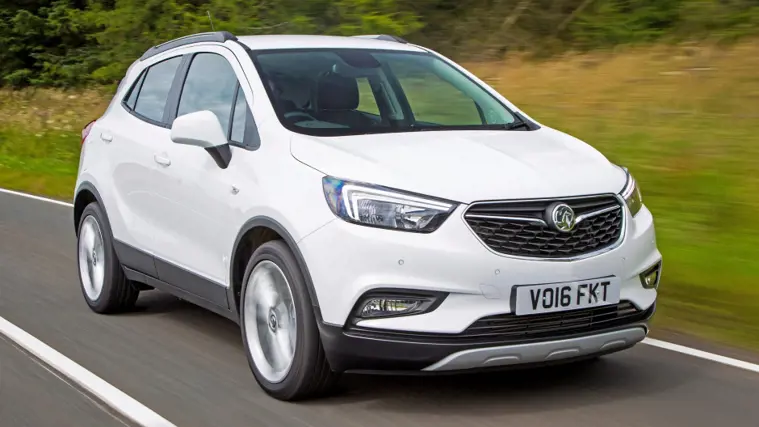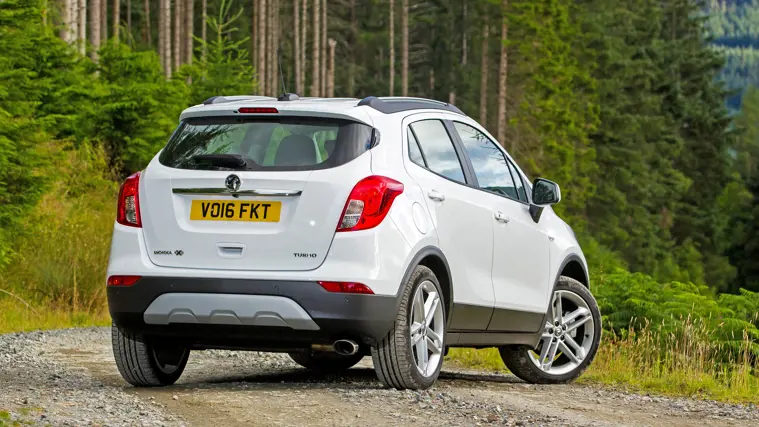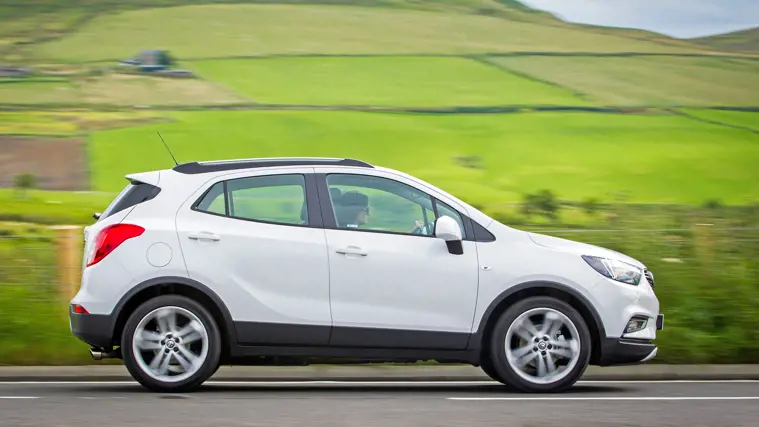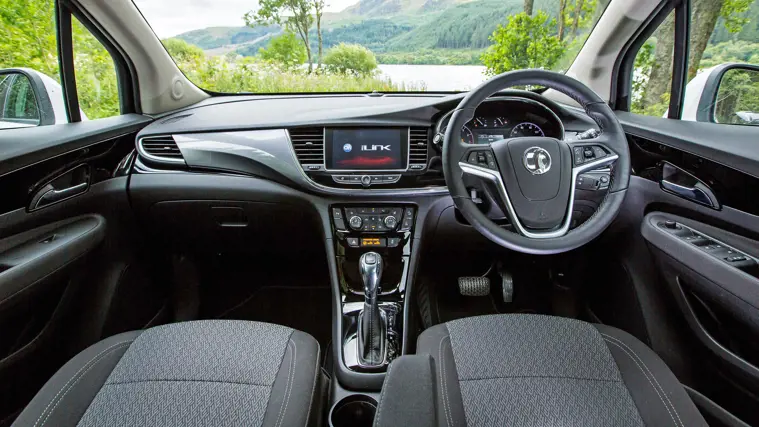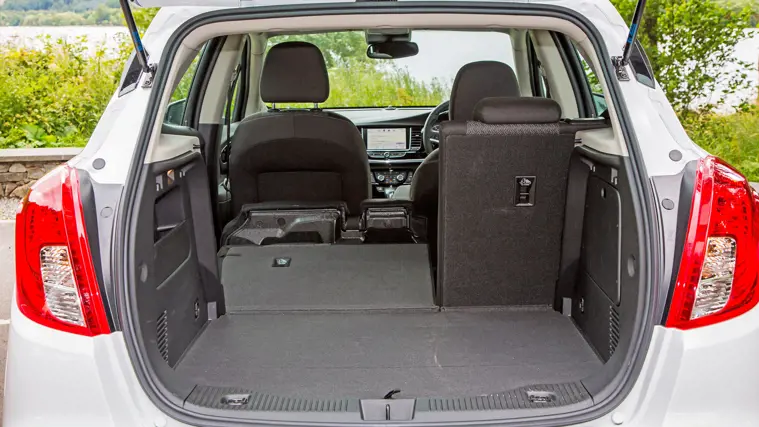Vauxhall Mokka X (2013-2019) Review
The Vauxhall Mokka X is a well-equipped family crossover, but it’s not great to drive and there are more appealing new car options
Strengths & weaknesses
- Lots of standard equipment
- Relatively practical and spacious
- High driving position
- Bumpy over rough roads
- Dated and was poor value new
- Rivals offer much greater all-round ability
Vauxhall Mokka X prices from £7,890 Finance from £158.92 per month
If you're looking for a small car with a high driving position, then you can opt for a small crossover - like a Renault Captur - which crosses the small dimensions of a supermini with the height of a sport utility vehicle (SUV).
For more space, there are larger crossovers, such as the Nissan Qashqai and Volkswagen Tiguan, with more legroom in the back and larger boots. And then there's the Vauxhall Mokka X. This sits in between both groups, providing more space in the back seats than a small crossover, but less boot capacity than a family crossover.
In theory, this makes the Mokka X easier to drive on narrow or crowded roads, while carrying a family of four in comfort - five at a push. In reality, however, Mokka X visibility is poor, making it harder to manouevre than such a compact car should be, while even much shorter rivals offer greater boot space. Keep reading to find out everything you need to know about the Vauxhall Mokka X.
Key facts
| Warranty | Three years/60,000 miles |
|---|---|
| Boot size | 356 litres |
| Width | 1,781mm |
| Length | 4,275mm |
| Height | 1,658mm |
| Tax | £145 to £500 in first year, then £145 thereafter (Pre-April 2017: £20-£180) |
Best Vauxhall Mokka X for...
Best for Economy – Vauxhall Mokka Design Nav 1.6 CDTi ecoFLEX
Vauxhall uses the ‘ecoFLEX’ badge to designate its most economical models. That version of the Mokka is powered by the 1.6-litre diesel engine, available in two power outputs. Fuel consumption is similar for both versions.
Best for Families – Vauxhall Mokka Design Nav 1.4i Turbo
Families who live in urban areas and use the Mokka as a runabout, with occasional longer trips, would be better off sticking to the more efficient of the two petrol versions, the 1.4i Turbo, which also includes lots of equipment in Design Nav specification.
Best for Performance – Vauxhall Mokka Elite Nav 1.4i Turbo
There isn’t really a ‘performance’ version of the Mokka, but the 1.4-litre turbocharged petrol engine makes it nippy enough. Elite Nav has all the creature comforts a typical buyer would want.
One to Avoid – Vauxhall Mokka Elite Nav 1.6i
The basic 1.6i petrol engine is disappointing, lacking the eagerness of the turbocharged petrols and diesels. You’ll have to work it hard to make progress, which will inevitably result in poorer-than-claimed fuel economy.
History
Relaunched in 2016 with an X at the end of its name and updated styling, the Mokka X is essentially the same car as the Vauxhall Mokka, which was on sale since 2013.
The mechanical parts are tightly packed, which has given the Vauxhall almost as much space inside as a Nissan Qashqai, Volkswagen Tiguan, Renault Captur or Ford Kuga, despite being 10-20cm shorter than them. As mentioned above, this is at the expense of boot space, though, with the 15cm shorter Citroen C3 Aircross offering nearly 50% more boot space.
The Mokka X does scores well with the equipment it offers as standard. Design Nav models come with a touchscreen media system and sat-nav, as well as dual-zone climate control and automatic headlights that switch on when it gets dark.
However, the price that Vauxhall charged for the Mokka X new would buy a larger Renault Kadjar or Seat Ateca, which is one reason why there were often large Vauxhall Mokka X cash discounts available. New Vauxhall Mokka X PCP finance deals were often poor value, too, meaning that while the Mokka X has less boot space than the smaller Seat Arona, you could get the larger, newer Ateca for less per month. Thankfully, as a used car the Mokka is much better value, with it being priced far more competitively against rivals.
The Mokka X's performance on poorly surfaced roads is one of the major criticisms of the car; it struggles to soak up the impacts, which results in a bumpy and bouncy ride - this is practically unacceptable for a car that doesn't handle corners well. The gearbox feels clunky to use too. Instead of being smooth and intuitive, you need to make a real effort to move the lever into the correct gear. The similarly-sized Skoda Yeti is more stable and has a better gearbox.
A range of petrol and diesel engines, as well as a number of trim levels with different levels of standard equipment ensure a good spread of prices and equipment to suit most needs and budgets. If you're wary of diesel, then the 1.4-litre petrol car offers reasonable power. The 1.6-litre diesel engine is much more economical and surprisingly quiet - so much so that Vauxhall has taken to calling it a 'whisper diesel'.
With chunky looks and a high driving position, the Mokka X could be mistaken for a small SUV that is designed to go off-road. But even if you select the option of four-wheel drive, the small gap between the ground and the bottom of the car, means that the Mokka X is unlikely to manage much more than relatively level grass and dirt tracks without being damaged. Four-wheel drive also worsens fuel economy.
The Mokka comes with Vauxhall's OnStar service, which includes a mobile phone sim card. This means that the car can automatically alert the emergency services in the event of a crash. It can also be tracked if stolen. Vauxhall offers what it calls a concierge service too: by pressing a button in the car, you'll be connected to a call centre, where an operator can set your car's destination and program the sat-nav remotely. You'll need to pay a subscription fee after the car is a year old.
Other safety equipment is less impressive. The Mokka X isn't available with automatic emergency braking, which has been proven to reduce crashes. It did score a full five stars out of five in 2012, by crash testing authority Euro NCAP. However, more recent tests are far more stringent. Therefore a rival car scoring five stars more recently is likely to provide a much greater level of protection.
Vauxhall Mokka X History
- March 2013 102 December 2012 Mokkas recalled for steering-wheel problem
- May 2013 1.4-litre turbocharged engine added to line-up
- October 2016 Updated Mokka relaunched as Mokka X, with new trim levels, but same engine range.
- 2020 Mokka X is discontinued to make way for a new version.
Understanding Vauxhall Mokka X names
Engine 1.6 CDTi (110)
The size of Mokka engines is given in litres. In general, larger engines are more powerful, but that's not always the case, so the horsepower of the engine is also provided (here it's 110hp). This figure may also be referred to as PS, reflecting the German term for horsepower. Diesel engines are badged 'CDTi', while petrol engines just have a single 'i'. Most Mokka engines are also turbocharged to boost power without a big increase in fuel use.
Efficiency ecoFLEX
This is the designation Vauxhall uses for its most efficient, eco-friendly models.
Trim level Active
The trim level indicates the amount of standard equipment fitted. The least-well equipped is Active, followed by Design Nav, Elite and then Elite Nav.
Vauxhall Mokka X Engines
Petrol: 1.4i Turbo, 1.6i Diesel: 1.6 CDTi
The Mokka engine range is pretty straightforward. The cheapest option is a 115hp 1.6-litre petrol engine. It’s the cheapest option but it feels pretty lifeless and takes a lazy 12.5 seconds to accelerate the car from 0-62mph. Fuel economy isn’t brilliant either, at an official 41.5mpg.
Efficiency isn’t a watchword of the more sophisticated 1.4-litre petrol engine, either. It is turbocharged, which is meant to boost power without dramatically increasing fuel economy, but only manages between 42.2mpg and 45.6mpg, based on official figures, depending on which gearbox you go for and whether you specify two-wheel drive or four-wheel drive. In real-world driving, that drops below 40mpg.
Despite being smaller than the 1.6-litre engine, it’s a much livelier performer, getting from 0-62mph just over two seconds quicker (9.9 seconds) and feeling more comfortable at motorway speeds. A new, more powerful 152hp version was also available in later models (only with an automatic gearbox), which improved acceleration.
The 1.6-litre diesel is the one to go for if you’re keeping an eye on running costs. Again, four-wheel drive reduces fuel economy, but if you go for the special ecoFLEX model with two-wheel drive, you’ll be getting a car with an official fuel economy figure of 68.9mpg, but which also accelerates quickly enough for safe overtaking and greater towing ability. It returns the same claimed fuel economy regardless of whether you go for the 110hp engine or 136hp version.
|
Fuel |
Fuel economy |
Power |
Acceleration (0-62mph) |
Top speed |
|
|
1.4i Turbo |
Petrol |
42.2-45.6mpg |
140hp |
9.9-10.7 secs |
118mph |
|
1.4i Turbo |
Petrol |
43.5mpg |
152hp |
9.4 secs |
120mph |
|
1.6i |
Petrol |
41.5mpg |
115hp |
12.5 secs |
106mph |
|
1.6 CDTi |
Diesel |
65.7-68.9mpg |
110hp |
12.5 secs |
111mph |
|
1.6 CDTi |
Diesel |
60.1-68.9mpg |
136hp |
9.9-10.9 secs |
119mph |
Vauxhall Mokka X Trims
Active, Design Nav, Elite, Elite Nav
Some other Vauxhalls have an almost bewildering number of versions, but the Mokka has just four for buyers to choose from: Design Nav, Active, Elite and Elite Nav. You can add various option packs to these, to increase the equipment on the car.
The least-well equipped trim level is Active, but it doesn't feel too spartan, as it comes with dual-zone climate control, windscreen wipers and headlights that come on automatically when needed. The latter can automatically switch between high and low beam to avoid dazzling traffic. There are front and rear parking sensors, electric-folding mirrors and alloy wheels: 17-inch on ecoFlex models and 18-inch on non-ecoFlex cars.
A seven-inch touchscreen media system called 'IntelliLink' is also standard, which has plenty of options to connect your phone, including Bluetooth for a wireless connection, plus Apple CarPlay and Android Auto, which convert the system to run in a similar way to your smartphone. There's a digital radio too.
All Mokka X cars have OnStar, which uses a mobile phone sim card to alert the emergency services if the Mokka X is involved in a crash. It can create a mobile WiFi hotspot and connect to a call centre where an operator can help with directions and remotely program your sat-nav. You'll need to pay a subscription fee to use this on cars that are over a year old.
Oddly, Design Nav has more equipment than Active but has a list price new that was around £2,000 cheaper. That's because Vauxhall's finance offers were usually less generous on this model, making monthly payments more expensive than an Active car. This isn't an issue with used cars, so these models which have a larger eight-inch touchscreen media system with sat-nav are well worth considering.
Elite cars add leather seat facings, heated front seats and steering wheel, 18-inch alloy wheels, tinted rear windows and a centre rear armrest with cupholders, but comes with the smaller touchscreen and no sat-nav. Elite Nav trim adds these latter gadgets back in.
All trim levels are available with four-wheel drive, and option packs include a rear-view camera, sunroof and brighter LED headlights, which can operate with partial main beam, which avoids dazzling other vehicles but still maintains maximum brightness on empty parts of the road.
Vauxhall Mokka X Reliability and warranty
The original Mokka came 75th out of 150 cars in the Auto Express Driver Power customer satisfaction survey. It was marked down for its driving experience and practicality (the 356-litre boot is smaller than a Volkswagen Golf’s) but a 36th-place finish for reliability indicates the Mokka X is likely to provide a hassle-free ownership experience.
Vauxhall’s dealers were ranked a middling-to-poor 22nd out of 32 brands in the same survey. It’s an improvement on past years, but it still means that the customer service experience, if something does go wrong with your Mokka, is unlikely to be sparkling.
In terms of warranty, Vauxhall offers three years or 60,000 miles (whichever comes first), which is pretty standard for most of the car industry, but a long way behind Kia’s seven years and Hyundai’s five.
Used Vauxhall Mokka X
Many of the used examples on the market are Vauxhall Mokkas, rather than the revised Mokka X. You can expect the earlier cars to sell at lower prices than the Mokka X equivalents because they look noticeably different, with a more dated design.
The engines are the same whether you choose the current or earlier car but the four different trim levels have different names. Exclusiv has a similar equipment level to the current Active level, Tech Line almost mirrors Design Nav, while SE is similar to Elite. Limited Edition was the only version to come with OnStar.
The Vauxhall Mokka wasn’t a class leader when new, so it’s not going to be the best second-hand buy, either, though it is much better value used, so if price is important to you, you should be able to get a decent Mokka for your budget.
The Mokka did lose value quickly as a new car, so low-mileage, newer examples can help you make the most of your budget. And the former entry-level Exclusiv model was well equipped, so there’s no need to splash out on harder-to-find high-spec models.
The 1.6-litre diesel Mokka offers plenty of value. This and the 1.4-litre turbocharged petrol models were the most popular engines from new, so there should be plenty available on the used market. As they’re generally used as family cars, many Mokkas will have only done fairly low mileages, so there should be plenty of life left in them.

